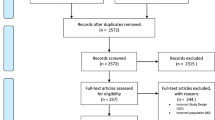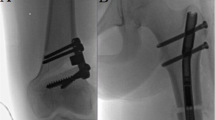Abstract
Background
The management of limb deformity, shortening, and bone defects in treatment of Ollier’s disease is a major challenge. This study aims to summarize and compare the different surgical treatments, and to evaluate the outcome and possible prognostic factors of leg lengthening in these patients.
Materials and methods
A systematic review of the literature from 1993 to 2017 was performed. Nineteen articles were found including a total of 121 patients with limb deformities because of Ollier’s disease. The mean patients’ age at the time of first surgery was 12 years. A total of 272 segments were surgically treated (14 segments in the upper limbs) with variable techniques including osteotomies and external fixation, intramedullary nails, as well as epiphysiodesis and lengthening over nail. We studied the bone healing index (BHI), distraction index (DI), distraction time, gained length, total treatment time, and complications.
Results
Available implants and techniques allowed correction of patients’ deformities (lengthening and correction of angular defects) in most cases. External fixators, circular or monolateral frames were the most commonly used technique. The Ilizarov external fixator was the most commonly used frame (196 segments). The BHI was significantly better when the external fixation was combined with intramedullary nails. Epiphysiodesis was most likely to be more associated with the past than to the present. Joint stiffness, infection, early consolidation, pathological fracture, deformity recurrence, delayed union, non-union, neurapraxia, and overlengthening were the reported complications with an overall rate of 27.9%.
Conclusions
There is no consensus for the optimal surgical technique and implants for correction of limbs deformities in patients with Ollier’s disease. External fixators most commonly circular are the most commonly used implants; however, complications do occur.

Similar content being viewed by others
References
Ollier M (1900) De la dyschondroplasie. Bull Soc Chir Lyon 3:22–27
Baumgart R, Bürklein D, Hinterwimmer S, Thaller P, Mutschler W (2005) The management of leg-length discrepancy in Ollier's disease with a fully implantable lengthening nail. J Bone Joint Surg 87(B):1000–1004
De Bastiani G, Aldegheri R, Renzi-Brivio L, Trivella G (1987) Limb lengthening by callus distraction (callotasis). J Pediatr Orthop 7(2):129–134
Shapiro F (1982) Ollier's disease. An assessment of angular deformity, shortening, and pathological fracture in twenty-one patients. J Bone Joint Surg 64:95–103
Kolodziej L, Kołban M, Zacha S, Chmielnicki M (2005) The use of the ilizarov technique in the treatment of upper limb deformity in patients with Ollier's disease. J Pediatr Orthop 25(2):202–205
Madan SS, Robinson K, Kasliwal PD, Bell MJ, Saleh M, Fernandes JA (2015) Limb reconstruction in Ollier's disease. Strat Trauma Limb Recon 10:49–54
Watanabe K, Tsuchiya H, Sakurakichi K, Yamashiro T, Matsubara H, Tomita K (2007) Treatment of lower limb deformities and limb-length discrepancies with the external fixator in Ollier's disease. J Orthop Sci 12:471–475
Ilizarov GA (1990) Clinical application of the tension-stress effect for limb lengthening. Clin Orthop Relat Res 250:8–26
Tellisi N, Ilizarov S, Fragomen AT, Rozbruch SR (2008) Humeral lengthening and deformity correction in Ollier's disease: distraction osteogenesis with a multiaxial correction frame. J Pediatr Orthop B 17:152–157
Jesus-Garcia R, Bongiovanni JC, Korukian M, Boatto H, Seixas MT, Laredo J (2001) Use of the Ilizarov external fixator in the treatment of patients with Ollier's disease. Clin Orthop Relat Res 382:82–86
Curran AR, Kuo KN, Lubicky JP (1999) Simultaneous Ipsilateral Femoral and tibial lengthening with the Ilizarov Method. J Pediatr Orthop 19(3):386–390
D'Angelo G, Petas N, Donzelli O (1996) Lengthening of the lower limbs in Ollier's disease: problems related to surgery. Chir Organi Mov 81(3):279–285
Myers GJ, Bache CE, Bradish CF (2003) Use of distraction osteogenesis techniques in skeletal dysplasias. J Pediatr Orthop 23:41–45
Pandey R, White SH, Kenwright J (1995) Callus distraction in Ollier's disease: a case report. Acta Orthop 66:479–480
Popkov D, Journeau P, Popkov A, Haumont T, Lascombes P (2010) Ollier's disease limb lenghtening: should intramedullary nailing be combined with circular external fixation? Orthop Trauma Surg Res 96:348–353
Märtson A, Haviko T, Kirjanen K (2005) Extensive limb lengthening in Ollier's disease: 25-year follow-up. Medicina (Kaunas) 41(10):861–866
Van Loon P, Lammens J (2008) Malformation of the humerus in a patient with Ollier’s disease treated with the Ilizarov technique. J Shoulder Elbow Surg 17:e9–e11
Goote P, Altiok H, Beck J, Smith P, Ackman J, Hassani S, Kurapati N (2017) Limb lengthening in pediatric patients with Ollier's disease. J Limb Lengthen Reconstr 3:37–44
Aronson J, Good B, Stewart C, Harrison B, Harp J (1990) Preliminary studies of mineralization during distraction osteogenesis. Clin Orthop Relat Res 250:43–49
Ilizarov GA (1989) The tension-stress effect on the genesis and growth of tissue: Part 1. The influence of stability of fixation and soft tissue preservation. Clin Orthop Relat Res 238:249–281
Cattaneo R, Villa A, Catagni M, Tentori L (1988) Limb lengthening in achondroplasia by Ilizarov's method. Int Orthop 12(3):173–179
Maffulli N, Pattinson RC, Fixsen JA (1993) Lengthening of congenital limb length discrepancy using callotasis: early experience of the hospital for sick children. Ann R Coll Surg Engl 75:105–110
Chew DK, Menelaus MB, Richardson MD (1998) Ollier's disease: varus angulation at the lower femur and its management. J Pediatric Orthop 18(2):202–208
Raimondo RA, Skaggs DL, Rosenwasser MP, Dick HM (1999) Lengthening of pediatric forearm deformities using the ilizarov technique: functional and cosmetic results. J Hand Surg 24A:331–338
Tsuchiya H, Morsy AF, Matsubara H, Watanabe K, Abdel-Wanis ME, Tomita K (2007) Treatment of benign bone tumors using external fixation. J Bone Joint Surg 89(B):1077–1783
Eralp L, Bilen FE, Rozbruch SR, Kocaoglu M, Hammoudi AI (2016) External fixation reconstruction of the residual problems of benign bone tumours. Strat Traum Limb Recon 11(1):37–49
Paley D (1990) Problems, obstacles, and complications of limb lengthening by the Ilizarov technique. Clin Orthop Relat Res 250:81–104
Liu J, Hudkins PG, Swee RG, Unni KK (1987) Bone sarcomas associated with Ollier's disease. Cancer 59:1376–1385
Schwartz HS, Zimmerman NB, Simon MA, Wroble RR, Millar EA, Bonfiglio M (1987) The malignant potential of enchondromatosis. J Bone Joint Surg Am 69:269–274
Richards SB, Cherkashin A, Samchukov M (2014) Varus deformity of the distal femur and LLD secondary to Ollier's disease corrected by gradual deformity correction and lengthening. In: Robert Rozbruch S, Hamdy Reggie (eds) Limb lengthening and reconstruction surgery case Atlas, pp 1–9. Springer International Publishing, Switzerland. https://doi.org/10.1007/978-3-319-02767-8_84-1
Funding
No benefits have been or will be received from a commercial party related directly or indirectly to the subject matter of this article.
Author information
Authors and Affiliations
Corresponding author
Ethics declarations
Conflict of interest
All authors declare that they have no conflict of interest.
Additional information
Publisher's Note
Springer Nature remains neutral with regard to jurisdictional claims in published maps and institutional affiliations.
Rights and permissions
About this article
Cite this article
Angelini, A., Baracco, R., Dolci, A. et al. Limb lengthening for deformities in Ollier’s disease: a systematic review. Eur J Orthop Surg Traumatol 30, 1325–1332 (2020). https://doi.org/10.1007/s00590-020-02692-5
Received:
Accepted:
Published:
Issue Date:
DOI: https://doi.org/10.1007/s00590-020-02692-5




